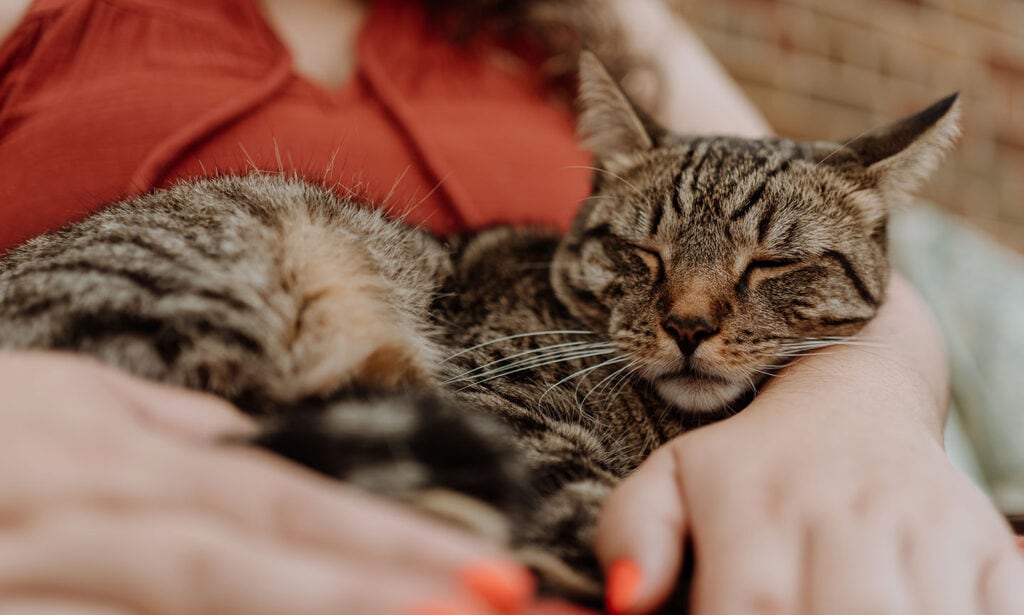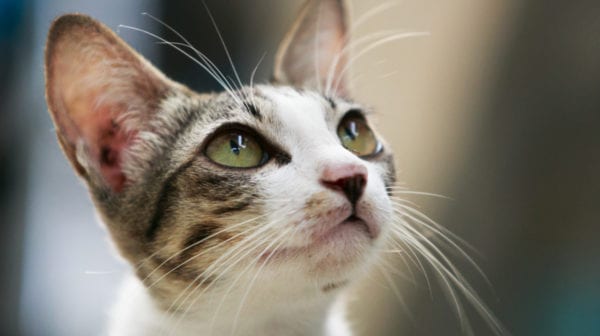Soft? Check. Fluffy? Check. Adorable? Check and check. With cozy-up qualifications like this, it’s no wonder we love snuggling our feline friends.
If you’re tempted to stop scrolling immediately and go find your cat, we understand. But before you do, consider reading on for a master class in Kitty Snuggles. From risks to rewards, breeds to body language, we asked the experts everything you need to know about cat cuddles.
Do Cats Like to Cuddle?
We like to cuddle cats. But what about our cats—do they enjoy a snuggle sesh?
Like all things cat-related, it depends. Some cats like to cuddle, some cats don’t, and many change their minds throughout the day. Regardless of whether you have a natural lap cat, don’t take it personally, advises Stephen Quandt, a certified cat behaviorist based in New York City.
“It depends on the cat and the context,” says Quandt. “A cat who cuddles with you clearly enjoys your company, but a cat who doesn’t cuddle with you doesn’t mean they don’t like you—they just don't need to do this with you right now.”
Some cat breeds are known to be more cuddly than others, says Dr. Nicole Savageau, VMD, a Texas-based veterinarian. These affectionate breeds include:
“It's important to remember that while these breeds may be known for being more affectionate, every cat is an individual, and may have different preferences for attention and cuddling,” adds Dr. Savageau.
Is it Good to Cuddle With Your Cat?
If you have a snuggly, cute cat, we have even more good news for you: Cuddling has well-being benefits for both you and your beloved pet!
Benefits for cats:
- Stress reduction: “Cuddling can help your cat feel more secure and loved, which can reduce stress and anxiety,” says Dr. Savageau.
- Bond strengthening: “It can also strengthen the bond between you and your cat, and provide a sense of comfort and companionship for both of you,” she adds.
- Physical benefits: “It can help regulate their body temperature, especially if they're feeling cold,” she says. “It can also provide a soothing massage for their muscles and joints, which can help relieve any tension or soreness.”
Benefits for people:
- Improved relaxation: A study by scientists at Washington State University found that petting cats and dogs significantly reduced stress levels in college students.
- Better heart health: Cat ownership is associated with decreased risk of death related to cardiovascular disease and high blood pressure, found a study by the National Institutes of Health.
- Stronger immune system: Stanford University researchers found that regular exposure to a cat or a dog could reduce a person’s chances of developing non-Hodgkin lymphoma, possibly due to an altered immune system.
How Often Should You Cuddle With Your Cat?
So, how much time should you block out on your calendar for cat cuddling? There’s no magic amount, experts say. What’s important is that you let your furry friend set the snuggle schedule.
“It would be best to let the cat approach you first, as some cats really have to be in the mood to cuddle,” says Dr. Dwight Alleyne, DVM, a Georgia-based veterinarian.
If you’re unsure about your cat’s agenda, Dr. Alleyne says to look for cuddling clues and cues:
- Rubbing against you
- Purring
- Jumping in your lap
What Are the Risks of Cuddling With a Cat?
Forced cuddling can lead to injuries for both cat owners and cats.
“It's important to remember that not all cats enjoy being cuddled,” Dr. Savageau says. “Cats are naturally independent animals, and may feel trapped or threatened if they're held too tightly. This can cause them to become fearful, anxious or stressed, and they may try to scratch or bite to escape.”
Learning body language is an important part of pet care. Signs your cat is not interested in snuggling include the following:
- Tail twitching or lashing
- Ears flattened back
- Struggling or trying to escape
- Growling, hissing or swatting
- Meowing or yowling
“If you notice any of these signs, it's important to respect your cat's boundaries and stop cuddling them,” says Dr. Savageau. “Instead, try to provide them with affection in ways that they enjoy, such as gentle petting or offering treats.”
How to Cuddle Your Cat: 5 Tips for Superior Snuggles
Ready for some next-level cuddle time? Consider these expert tips for snuggling success.
1. Let your cat make the first move.
Playing it cool is essential when it comes to cats. “There is good evidence that cats seek out people who don’t seek them out,” says Quandt. “Being overly demonstrative to your cat might be a turn-off—but let them come to you, and they are yours.”
2. Provide safe, comfortable support.
Your cat is placing trust in you when jumping into your lap or arms, so be sure to provide a safe, sturdy resting place. “If your cat enjoys being held, it's best to support their body weight and avoid squeezing them too tightly,” says Savageau. “You can also try wrapping them in a soft blanket or towel to help them feel more secure.”
3. No squeezing.
Louder for the cat parents in the back: No squeezing! “It is not recommended that you hold a cat tightly, as it may be perceived as a threat by a cat,” Dr. Alleyne says.
4. Pay attention to body language.
Whenever holding or snuggling a cat, pay close attention to their body language; they can’t technically ask to be put down, but they have plenty of ways of telling you. While hissing, struggling and flattened ears are classic cues, every cat is an individual. “Learn body language, and specifically, your cat’s body language,” recommends Quandt.
Learn how to decode cat body language.
5. Monitor interactions with children.
In general, kids are not great cat cuddlers. If you have young children in your home, ensure your pet is safe and comfortable. “It's important to teach children to be gentle and respectful when handling cats,” says Dr. Savageau. “Young children should always be supervised when interacting with cats, and they should be taught to approach them calmly, and avoid rough play or grabbing.”
More Purrs Ahead!
As cat lovers know, there’s nothing like cuddling up with a sleepy tabby and hitting the “next episode” button. But as curious creatures with wild ancestors, cats need plenty of active enrichment to live their best (nine) lives. For ideas on how to punch up playtime, check out these fun, interactive ideas!
Learn more about your cat's quirks:
Share:









